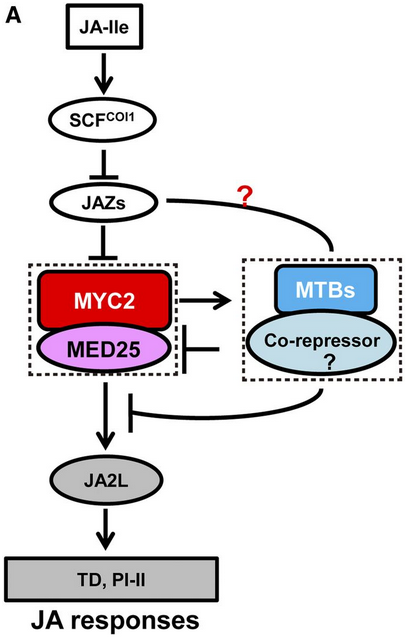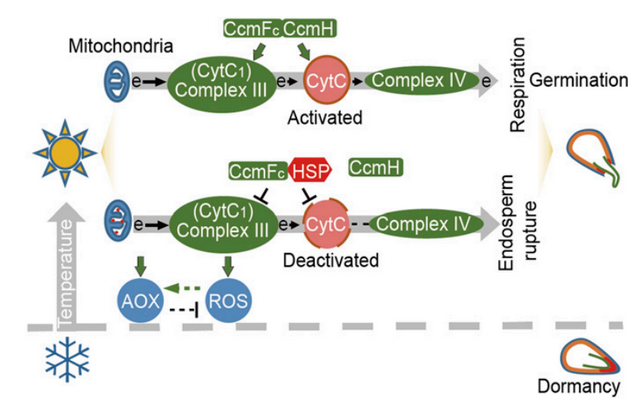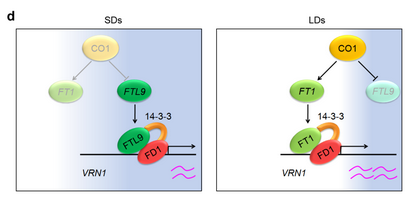Molecular details of key steps in crop growth uncovered by researches from the College of Agriculture and Biotechnology
China’s large population poses great challenge on producing sufficient crops to meet growing demand on food, feed grain, oil and other consumer goods. Meanwhile it is also a critical question about maintaining the quality and quantity of resources for future generations. Therefore, it is important to conduct research on issues that affect horticultural breeding, growth, and production.
Recently researchers from the College of Agriculture and Biotechnology answered three key questions regarding to crop growth at the molecular level.
1) negative feedback loop for induced defense against pest in tomatoes
Through the joint efforts of the research team led by Prof. WANG Qiaomei in ZJU and the LI Chuanyou Lab in the CAS Institute of Genetics and Developmental Biology, a novel “braking” mechanism of MYC2 is found in regulating the termination of jasmonate (JA, known plant volatiles responding to pest attacks) signaling via an autoregulatory negative feedback loop. Relevant findings are published in the journal of The Plant Cell.
This work started with a surprising result from a genetic experiment on MYC2, one of important regulatory protein in JA signaling pathway. They initially hypothesized that overexpression of MYC2 should enhance JA defense responses, however the opposite trend were observed in tomato plants. This triggers the authors to look for possible downstream targets of MYC2 responsible for the observed negative regulation. Through several molecular biological experiments, MTBs are identified. Futher study on CRISPR/Cas9 mtb tomato lines shows increased resistance to herbivore attack, but with no visible alterations in other agronomical traits, such as growth.

“The work has potential applications in sustainable crop production, since it may offer a strategy to engineer the relationships between growth and defense”, the editor of the journal wrote in a commentary about this study.
2) The thermal sensing protein in seed germination
How do seeds sense changes in temperature? The research team headed up by Prof. ZHANG Tianzhen engage in research into this question. They discover that GhHSP24.7—a mitochondrial matrix-localized heat stock protein—can regulate seed germination in a temperature-dependent manner. This finding opens up an avenue for molecular regulation in response to thermal changes and is of vital importance in seed production, preservation and breeding, particularly in cotton seeds in low-temperature, arid and saline-alkaline soils in Xinjiang province. This work is published in the PNAS.
Suppression of GhHSP24.7 renders seeds insensitive to temperature changes and delays germination even at a relatively high temperature. In contrast, active expression of GhHSP24.7 can contribute to expeditious seed germination even at a relatively low temperature. The variations in the speed of seed germination are found to depend on the differences in the puncture force of the endosperm rather than in the vitality of the embryo. In other words, GhHSP24.7 alters the physical force that inhibits seed germination via thermal sensing. Meanwhile, their experiments also show thermal sensing function of this gene is conserved across plant species. Therefore, HSP24.7 is a critical factor that positively controls seed germination via temperature-dependent reactive oxygen species generation.

3) Fine-tune modulation of photoperiodic flowering
Flowering is an essential part of the growth and development stage, which produces a direct impact on the length and propagation speed of plant growth. The agronomic traits of the heading stage in improved crops are of immense significance for expanding the range of new varieties, boosting crop yields and enhancing crop resistance.

Facultative long-day plants, including Arabidopsis and temperate grasses, trigger rapid flowering in long-day conditions (LDs) and delay flowering under short-day conditions (SDs). The research team led by WU Liang recently published an article entitled“Divergent roles of FT-like 9 in flowering transition under different day lengths in Brachypodiumdistachyon” in the journal of Nature Communications. In this stugy the antagonistic functions of FTL9 for flowering is discovered under different day-length environments, which will contribute to understanding the multifaceted roles of FT in fine-tune modulation of photoperiodic flowering in plants and offers useful clues to wheat breeding.